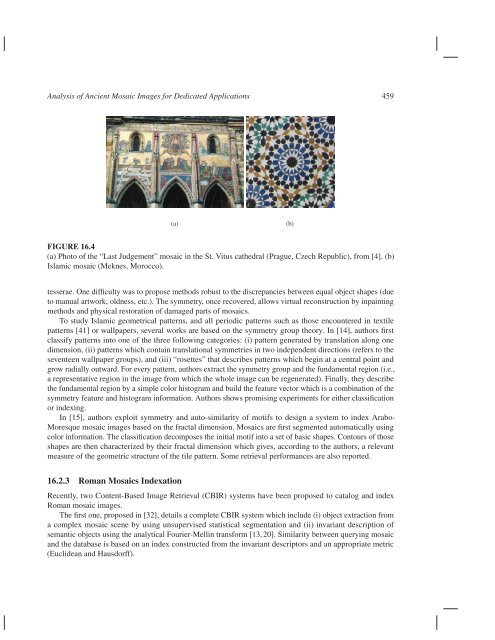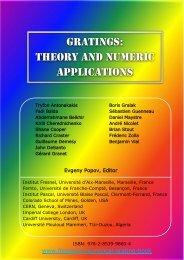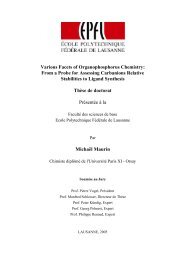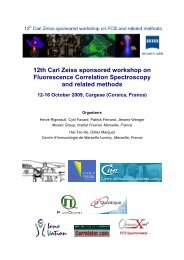Analysis of Ancient Mosaic Images for Dedicated ... - Institut Fresnel
Analysis of Ancient Mosaic Images for Dedicated ... - Institut Fresnel
Analysis of Ancient Mosaic Images for Dedicated ... - Institut Fresnel
You also want an ePaper? Increase the reach of your titles
YUMPU automatically turns print PDFs into web optimized ePapers that Google loves.
<strong>Analysis</strong> <strong>of</strong> <strong>Ancient</strong> <strong>Mosaic</strong> <strong>Images</strong> <strong>for</strong> <strong>Dedicated</strong> Applications 459<br />
(a) (b)<br />
FIGURE 16.4<br />
(a) Photo <strong>of</strong> the “Last Judgement” mosaic in the St. Vitus cathedral (Prague, Czech Republic), from [4]. (b)<br />
Islamic mosaic (Meknes, Morocco).<br />
tesserae. One difficulty was to propose methods robust to the discrepancies between equal object shapes (due<br />
to manual artwork, oldness, etc.). The symmetry, once recovered, allows virtual reconstruction by inpainting<br />
methods and physical restoration <strong>of</strong> damaged parts <strong>of</strong> mosaics.<br />
To study Islamic geometrical patterns, and all periodic patterns such as those encountered in textile<br />
patterns [41] or wallpapers, several works are based on the symmetry group theory. In [14], authors first<br />
classify patterns into one <strong>of</strong> the three following categories: (i) pattern generated by translation along one<br />
dimension, (ii) patterns which contain translational symmetries in two independent directions (refers to the<br />
seventeen wallpaper groups), and (iii) “rosettes” that describes patterns which begin at a central point and<br />
grow radially outward. For every pattern, authors extract the symmetry group and the fundamental region (i.e.,<br />
a representative region in the image from which the whole image can be regenerated). Finally, they describe<br />
the fundamental region by a simple color histogram and build the feature vector which is a combination <strong>of</strong> the<br />
symmetry feature and histogram in<strong>for</strong>mation. Authors shows promising experiments <strong>for</strong> either classification<br />
or indexing.<br />
In [15], authors exploit symmetry and auto-similarity <strong>of</strong> motifs to design a system to index Arabo-<br />
Moresque mosaic images based on the fractal dimension. <strong>Mosaic</strong>s are first segmented automatically using<br />
color in<strong>for</strong>mation. The classification decomposes the initial motif into a set <strong>of</strong> basic shapes. Contours <strong>of</strong> those<br />
shapes are then characterized by their fractal dimension which gives, according to the authors, a relevant<br />
measure <strong>of</strong> the geometric structure <strong>of</strong> the tile pattern. Some retrieval per<strong>for</strong>mances are also reported.<br />
16.2.3 Roman <strong>Mosaic</strong>s Indexation<br />
Recently, two Content-Based Image Retrieval (CBIR) systems have been proposed to catalog and index<br />
Roman mosaic images.<br />
The first one, proposed in [32], details a complete CBIR system which include (i) object extraction from<br />
a complex mosaic scene by using unsupervised statistical segmentation and (ii) invariant description <strong>of</strong><br />
semantic objects using the analytical Fourier-Mellin trans<strong>for</strong>m [13, 20]. Similarity between querying mosaic<br />
and the database is based on an index constructed from the invariant descriptors and an appropriate metric<br />
(Euclidean and Hausdorff).













